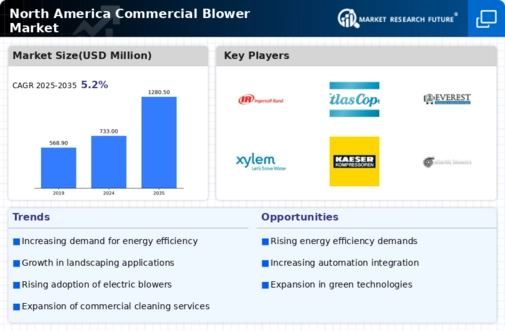Market Share
North America Commercial Blower Market Share Analysis
The highly competitive nature of the North American Commercial Blower Market has driven companies to use different positioning strategies to gain market share. One of the most common ways of doing this is through differentiation, where firms try to separate their products from those of rivals by using unique features, higher performance quality, or new technologies. Alternatively, it might be done by running low-cost leadership campaigns whereby companies concentrate on cutting down production expenses plus making their operations more efficient so as to offer goods at affordable prices, thus capturing bigger sections of price-sensitive customers. This becomes significant in companies pursuing such a strategy since emphasis would be placed upon economies of scale alongside proper management of supply chains, which will allow them to retain profitability levels while remaining competitive in terms of costs too. Another crucial strategy adopted by companies in the North America Commercial Blower Market is market segmentation. Companies can customize their products and marketing strategies to suit specific preferences in each segment by dividing the market into distinct segments based on industry, application, or customer needs. Additionally, strategic alliances and partnerships are also important tools for positioning in the market share. Companies can reach further and establish existing networks through collaboration with distributors, suppliers, or complementary businesses. Joint ventures and partnerships offer access to new markets, technologies, or distribution channels that foster growth and improve market share. Furthermore, North American commercial blower makers must concentrate on customer-centric tactics. Superior customer support services should be practiced by building strong relationships with customers post-purchase through exceptional customer service delivery systems as well as product warranties, which are geared towards brand loyalty and positive word-of-mouth referrals. In addition to this, the digital transformation era has seen it necessary to make use of online platforms and e-commerce channels as a strategy for positioning themselves in terms of market shares. This translates into investments in a robust online presence, user-friendly websites, and e-commerce capabilities so that they can expand the target audience, among other things. In addition, continuous innovation alongside improvement is critical for any firm aspiring to become a market leader because it helps keep pace with shifting consumer tastes about products. By doing so, firms develop cutting-edge products that meet their ever-changing needs, thereby attracting new clients while retaining those who already exist, thus leading to long-term growth in terms of their relative share.





Leave a Comment